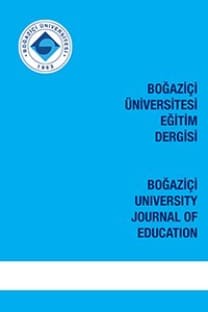Pedagogical Issues in Developing Mobile Assisted Language Learning Materials
This paper discusses the issues involved in developing mobile assisted language learning (MALL) materials based on the materials development process for a Leonardo da Vinci (LdV) Transfer of Innovation Project entitled Mobile Learning for Young People at Risk Groups (MLARG). The materials were developed for Grade 9 and 10 students in tourism vocational high schools in Turkey to be used as supplementary self-access materials supporting English learning at school. The paper provides a detailed account of the decisions taken to develop the materials as well as the pedagogical challenges that were faced during the development process.
Anahtar Kelimeler:
Mobile assisted language learning, Materials development
Pedagogical Issues in Developing Mobile Assisted Language Learning Materials
This paper discusses the issues involved in developing mobile assisted language learning (MALL) materials
based on the materials development process for a Leonardo da Vinci (LdV) Transfer of Innovation Project
entitled Mobile Learning for Young People at Risk Groups (MLARG). The materials were developed for
Grade 9 and 10 students in tourism vocational high schools in Turkey to be used as supplementary self-access
materials supporting English learning at school. The paper provides a detailed account of the decisions taken
to develop the materials as well as the pedagogical challenges that were faced during the development
process
___
- Alptekin, C. (2006). Cultural familiarity in inferential and literal comprehension in L2 reading. System, 34, 494-508.
- Alexander, P.A., & Jetton, T.L. (2003). Learning from traditional and alternative texts: New conceptualization for an information age. In A.C. Graesser, M. A. Gernsbacher, & S. R. Goldman (Eds.), Handbook of discourse processes (pp. 199–241). Mahwah, NJ: Erlbaum.
- Brown, J. D. (1995). The elements of language curriculum: A systematic approach to program development. Boston: Heinle & Heinle.
- Deimann, M., & Keller, J.M. (2006). Volitional aspects of multimedia learning. Journal of Educational Multimedia and Hypermedia, 15, 137–158.
- Dubin, F., & Olshtain, E. (1991). Course design: Developing programs and materials for language learning. Cambridge: Cambridge University Press.
- Ellis, J., & Ellis, P. (1987). Learning by design: Some criteria in EFL coursebooks. In L. E. Sheldon (Ed.), ELT textbooks and materials: Problems in evaluation and development (pp. 90–98). Oxford: The British Council.
- Hutchinson, T., & Waters, A. (1987). English for specific purposes. Cambridge: Cambridge University Press.
- Kramsch, C., & Anderson, R. W. (1999). Teaching text and context through multimedia. Language Learning and Technology, 2, 31–42.
- Kukulska-Hulme, A. (2005). Introduction. In A. Kukulska-Hulme & J. Traxler (Eds.), Mobile learning: A handbook for educators and trainers (pp. 1–6). London: Routledge.
- Kukulska-Hulme, A. & Shield, L. (2008). An overview of mobile assisted language learning: From content delivery to supported collaboration and interaction. ReCALL, 20, 271–289.
- Levy, M., & Kennedy, C. (2005). Learning Italian via mobile SMS. In A. Kukulska-Hulme & J. Traxler (Eds.), Mobile learning: A handbook for educators and trainers (pp. 76-83). London: Taylor and Francis.
- Mielo, G. (2005). The medium is the moblog. ETC: A Review of General Semantics, 62, 28–35.
- Nah, K. C., White, P., & Sussex, R. (2008). The potential of using a mobile phone to access the Internet for learning EFL listening skills within a Korean contex. ReCALL, 20, 331–347.
- Plass, J. L., & Jones, L. C. (2005). Multimedia learning in second language acquisition. In R. E. Mayer (Ed.), The Cambridge handbook of multimedia learning (pp. 467–488). New York: Cambridge University Press.
- Richards, J. C. (2001). Curriculum and development in language teaching. Cambridge: Cambridge University Press.
- Sandberg, J., Maris, M, & de Geus, K. (2011). Mobile English learning: An evidence-based study with fifth graders. Computers and Education, 57, 1334–1347.
- Scheiter, K., & Gerjets, P. (2007) Learner control in hypermedia environments. Educational Psychology Review, 19, 285–307.
- Stockwell, G. (2007). Vocabulary on the Move: Investigating an intelligent mobile phone-based vocabulary tutor. Computer Assisted Language Learning, 20, 4, 365–383.
- Sweller, J. (1988). Cognitive load during problem solving: Effects on learning. Cognitive Science, 12, 257–285.
- Thornton, P., & Houser, C. (2003). Using mobile web and video phones in English language teaching: Projects with Japanese college students. In B. Morrison, C. Green & G. Motteram (Eds.), Directions in CALL: Experience, experiments & evaluation (pp. 207–224). Hong Kong: Hong Kong Polytechnic University.
- ISSN: 1300-9567
- Yayın Aralığı: Yılda 2 Sayı
- Başlangıç: 1976
- Yayıncı: Boğaziçi Üniversitesi
Sayıdaki Diğer Makaleler
Subsystem for M/E-learning and Virtual Training based on IMS NGN Architecture
Pavol PODHRADSKÝ, Radovan KADLİC, Ondrej LÁBAJ, Juraj LONDÁK, Peter TRÚCHLY
Needs-Analysis: The First Step in Content Development for Mobile Learning
Yasemin BAYYURT, Nur Başak KARATAŞ
Pedagogical Issues in Developing Mobile Assisted Language Learning Materials
M-Learning System Implementation and Features
Jaromír HRAD, Tomáš ZEMAN, Marek NEVOSAD
Exploring the Major Determinants of Mobile Learning Adoption
